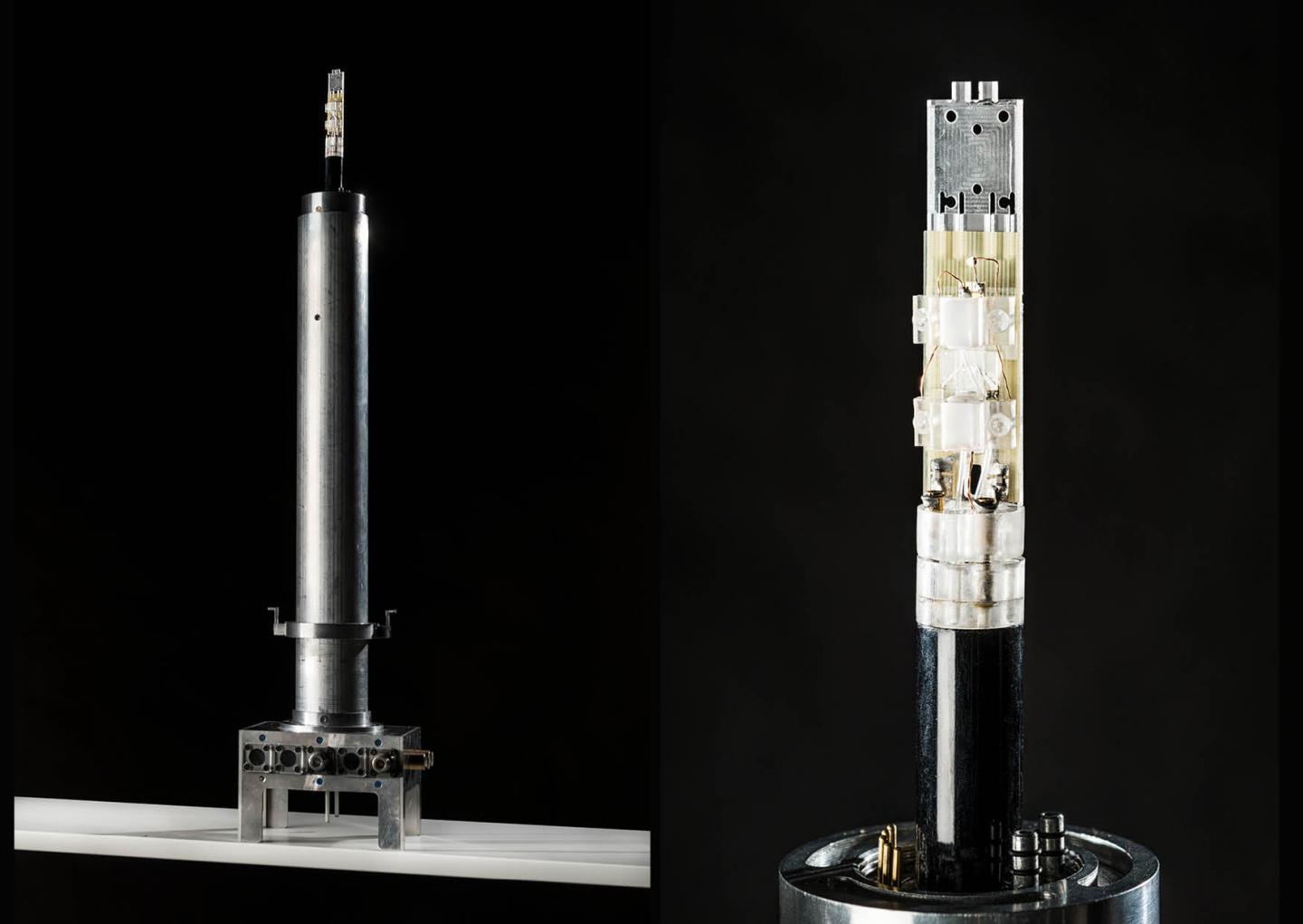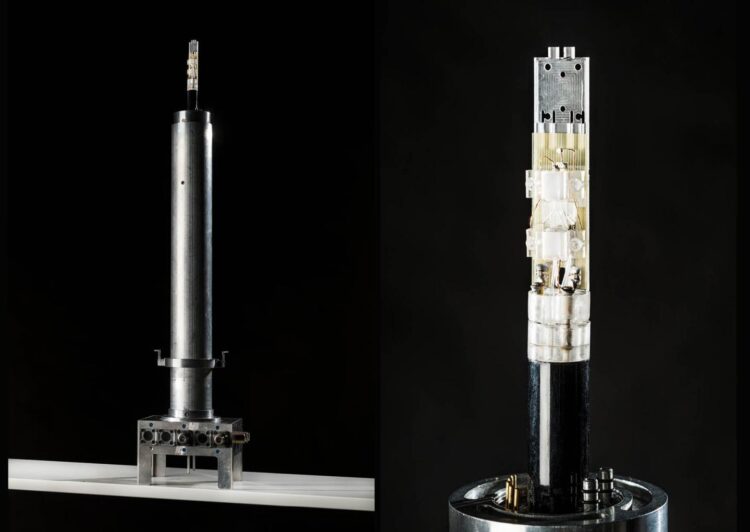Processes are accelerated by a factor of 10,000 — European Research Council funds KIT re-searchers and partners involved in the HiSCORE Project

Credit: (Photos: Markus Breig, KIT)
Nuclear magnetic resonance (NMR) is an important tool in drug research, since it can quantify and spatially resolve binding of drugs to pathogens. So far, however, NMR has lacked the sen-sitivity and throughput to scan large libraries of drug candi-dates. Within the “HiSCORE” project, research teams of Pro-fessor Jan Gerrit Korvink and Dr. Benno Meier from Karlsruhe Institute of Technology (KIT), in cooperation with partners from Paris and Nijmegen, will now develop a method for high-throughput screening (HTS). This project will be funded by a Synergy Grant awarded by the European Research Council (ERC).
The team of Jan Gerrit Korvink, Director of the Institute of Micro-structure Technology of KIT, will use MEMS miniaturization tech-nology to conduct a large number of measurements in parallel. “The available space in NMR magnets is completely underutilized,” Korvink says. Use of its full potential would largely increase func-tionality and efficiency.
The teams of Benno Meier from KIT’s Institute for Biological Inter-faces and Professor Arno Kentgens from Radboud University in Nijmegen will develop methods for parallel orientation or polariza-tion of nuclear spins in the samples. Nearly all spins contribute to the signal and signal intensity can be increased by up to four or-ders of magnitude compared to standard NMR experiments. It is also important to generate these hyperpolarized liquids at a suffi-ciently high rate. A boost in signal strength enables a significant reduction in sample size and required material. This reduction in sample size will pave the way towards parallelization.
In Paris, the team of Professor Geoffrey Bodenhausen will improve methods to quantitatively evaluate interactions between biomole-cules and drug molecules. The HiSCORE team will be advised by Dr. Alvar Gossert, ETH Zurich, and Claudio Dalvit, Trieste, both experts in pharmaceutical drug screening.
“HiSCORE” Will Highly Accelerate Process Steps
At all sites, technical systems will be developed and experiments will be conducted in parallel, Korvink says. “Within this ambitious project, we will build a system that will be improved continuously by all partners. In the first steps, this will be a complex process, but further development steps will be greatly accelerated.”
Conventional HTS methods are able to test up to one million sub-stance candidates, but provide information of low dimensionality and poor quality. NMR provides very rich information, but with a low throughput and at high cost so far.
HiSCORE (Highly Informative Drug Screening by Overcoming NMR Restrictions) merges all most innovative branches in the field of NMR – hyperpolarization, microcoils, microfluidics, parallel ac-quisition, and machine learning – to tackle these pharmacological challenges. In this way, processes will be accelerated by a factor of 10,000. “Together, we will develop and test a number of technol-ogies at the three sites Karlsruhe, Paris, and Nijmegen,” says Benno Meier, “so that we can quickly identify and push the most promising strategies for the various biophysical assays that we want to implement.”
###
About the Persons
Professor Jan Gerrit Korvink received his M.Sc. degree in Mechan-ical Engineering from the University of Cape Town, South Africa, in 1987 and his PhD degree from ETH Zurich, Switzerland, in 1993. In 1997, he joined the University of Freiburg as Professor for Mi-crosystems Engineering and co-directed the Freiburg Institute for Advanced Studies. In 2015, he joined KIT, where he heads the In-stitute of Microstructure Technology. He also is speaker of the Helmholtz Programme “Science and Technology of Nanosystems” and Principal Investigator of the 3D Matter Made to Order Cluster of Excellence. Korvink is author or co-author of more than 240 pub-lications in the area of microsystems. He is founding editor of “Ad-vanced Micro and Nanosystems” and co-founder of Voxalytic GmbH.
Benno Meier received his doctorate in physics from the University of Leipzig in 2012. Then, he joined the University of Southampton, UK, where he intensified research into magnetic resonance. In 2018, he was awarded an Early Career Fellowship by the Engineer-ing and Physical Sciences Research Council UK. In 2019, he joined KIT’s Institute for Biological Interfaces with a Helmholtz Young Investigators Group on hyperpolarized magnetic resonance. He is co-founder of Hyperspin Scientific UG.
ERC Synergy Grants
The European Research Council (ERC) awards Synergy Grants to groups of two to four principal investigators working together and bringing different skills to tackle ambitious research problems. Eligible are excellent young scientists as well as established active researchers with outstanding scientific achievements. The grant amounts to about EUR 14 million for a duration of six years. EUR 7.5 million will go to KIT.
To date, the ERC has funded more than 9500 cutting-edge re-searchers in various stages of their careers as well as more than 50,000 postdocs, doctoral researchers, and other research staff and teams.
As obvious from this year’s call, competition is rather hard: More than 440 proposals were submitted, of which 34 projects were se-lected for a Synergy Grant.
KIT researchers have received 20 grants of the ERC so far: Ten Starting Grants for outstanding early-stage researchers, four Con-solidated Grants for excellent researchers, whose independent teams are in the consolidation phase, five Advanced Grants for pioneer projects of established researchers, and now the first Syn-ergy Grant that was announced for the second time only in the current Horizon 2020 EU research framework programme.
Press contact: Johannes Wagner, Press Officer, Phone: +49 721 608-41175 , Email: [email protected]
Being “The Research University in the Helmholtz Association,” KIT creates and imparts knowledge for the society and the envi-ronment. It is the objective to make significant contributions to the global challenges in the fields of energy, mobility and infor-mation. For this, about 9,300 employees cooperate in a broad range of disciplines in natural sciences, engineering sciences, economics, and the humanities and social sciences. KIT pre-pares its 24,400 students for responsible tasks in society, indus-try, and science by offering research-based study programs. Innovation efforts at KIT build a bridge between important sci-entific findings and their application for the benefit of society, economic prosperity, and the preservation of our natural basis of life. KIT is one of the German universities of excellence.
This press release is available on the internet at http://www.
Media Contact
Monika Landgraf
[email protected]
Original Source
http://www.






